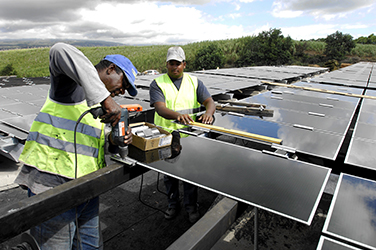 Defining what kinds of cleaner technologies are best suited to a country’s climate change needs can be a serious challenge in developing countries. The GEF-funded Technology Needs Assessment (TNA) project, which drew to a close in April 2013, has helped dozens of countries tackle the question, and set them on the path towards getting the chosen technologies up and running. Implemented by UNEP with the collaboration of the UNEP-DTU Partnership, the TNA project supported 36 countries as they tracked their evolving needs for new equipment, techniques, knowledge, and skills for mitigating greenhouse gas emissions and reducing vulnerability to climate change.
Defining what kinds of cleaner technologies are best suited to a country’s climate change needs can be a serious challenge in developing countries. The GEF-funded Technology Needs Assessment (TNA) project, which drew to a close in April 2013, has helped dozens of countries tackle the question, and set them on the path towards getting the chosen technologies up and running. Implemented by UNEP with the collaboration of the UNEP-DTU Partnership, the TNA project supported 36 countries as they tracked their evolving needs for new equipment, techniques, knowledge, and skills for mitigating greenhouse gas emissions and reducing vulnerability to climate change.
As important as it was to identify appropriate technologies, the TNA project went further, helping participating countries to create Technology Action Plans (TAPs). These specialized action plans recommend frameworks for diffusing the selected technologies, and help pinpoint appropriate projects and financing activities. They also offer practical solutions for removing policy, finance, and technological barriers.
The project’s success was such that in August 2014 the GEF endorsed a second round TNAs for an additional 25 countries. The specific countries have now been targeted, and TNA II is scheduled to launch by the end of 2014, with the first inception missions to target countries starting in January 2015. Countries are lining up to participate: a number of countries that are not yet included in TNA II, including Pakistan, Afghanistan and Belize, have contacted UNEP DTU Partnership to express their desire to participate in the new phase or otherwise receive support for implementing TNAs.
Less than two years after the completion of TNA’s first round, a number of positive outcomes are already emerging from target countries. In Costa Rica, for example, the TNA is serving as a methodological guide for identifying and prioritizing adaptation and mitigation technologies, a valuable support that will help the country meet its carbon neutrality goal by 2021. TNA has also served as a platform for designing NAMAs in Costa Rica’s transport and energy sectors. Similar outcomes can be found in Vietnam, where TNA results are being integrated into NAMAs in the energy and agriculture sectors. In Moldova, where TNA results are informing environmental policy-making, the government is already working on ways of introducing climate technologies, and in Ecuador and Mauritius, TNAs are being worked into national policy frameworks.
Taking Action through TNA in Lebanon
One country that has directly benefited from the first phase of the TNA project is Lebanon, where needs assessments were followed up by a number of TAPs. Several of these action plans are currently being implemented. One, which is also being developed into a NAMA, is a plan to expand the market for fuel-efficient and hybrid cars. In a country where water supply is a constant concern, another TAP initiative aims to harvest rainwater from greenhouse roofs, an idea that will be expanded into a pilot project under the country’s national action plan. Other TNA-inspired agricultural projects are currently under consideration by the Ministry of Agriculture’s Agrical project, and the Ministry of Environment’s Climasouth project.
For more information about the TNA project, please visit www.tech-action.org